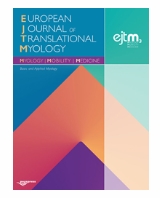Tommasini E1,2,3, Missaglia S1,2, Vago P1,2, Galvani C2,3, Pecci C4, Rampinini E4,5, Bosio A4, Morelli A4, Bonanomi A6, Silvestrini A7, Mordente A7, Tavian D1,2
- Laboratory of Cellular Biochemistry and Molecular Biology, CRIBENS, Università Cattolica del Sacro Cuore, Milan, Italy;
- Department of Psychology, Università Cattolica del Sacro Cuore, Milan, Italy;
- Exercise & Sport Science Laboratory, Università Cattolica del Sacro Cuore, Milan, Italy;
- Human Performance Laboratory, MAPEI Sport Research Center, Olgiate Olona, Italy
- Sport and Exercise Discipline Group, Human Performance Research Centre, Faculty of Health, University of Technology Sydney, Moore Park, NSW;
- Department of Statistical Science, Università Cattolica del Sacro Cuore, Milan, Italy;
- Department of Basic Biotechnological Sciences, Intensivological and Perioperative Clinics, Università Cattolica del Sacro Cuore, Rome, Italy.

Abstract
This study aimed to analyze the acute impact of exercise on serum irisin levels in 22 young (YA, 24.6 ± 3.5 yrs) and in 12 middle-aged male adults (MA, 54.6 ± 5.7 yrs) 15 min and 24 h after an incremental cycling exercise test to exhaustion. ELISA assay was used for serum irisin detection. Circulating irisin increased significantly from baseline (9.0 ± 2.0 ng/ml) to 15 min post-exercise (10.2 ± 2.0 ng/ml, P < 0.001), but the greatest increment was detected after 24 h (13.5 ± 2.5 ng/ml, P < 0.001) reaching more than 50% of the basal release. Levels were significantly higher in YA (9.7 ± 1.7 to 11.1 ± 1.8 to 14.5 ± 2.2 ng/ml) than MA (7.6 ± 1.6 to 8.7 ± 1.5 to 11.8± 2.2 ng/ml) for all measured time-points (P < 0.05). Nevertheless, MA showed a comparable increase in serum irisin levels when compared to YA. These findings highlight the importance of acute physical exercise as a countermeasure against age-related deterioration of skeletal muscle mass and function in both YA and MA.
Eur J Transl Myol, 2024 Jul 1
PMID: 38949080 PMCID: PMC11264220 DOI: 10.4081/ejtm.2024.12693